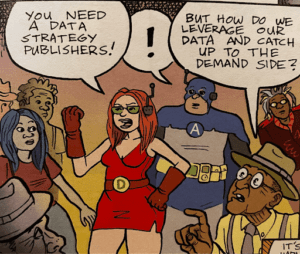 “Data Driven Thinking” is written by members of the media community and contains fresh ideas on the digital revolution in media.
“Data Driven Thinking” is written by members of the media community and contains fresh ideas on the digital revolution in media.
Today’s column is written by Gurman Hundal, Co-founder at Media IQ.
The expression “the elephant in the room” feels rather fitting when considering barriers to display trading innovation. As digital marketers, we have many “elephants” — challenges that are holding our industry back from growth–that are being ignored for the sake of ease. Why? Because it’s far easier to do nothing, especially if times are good. Nobody wants to be the person who points out the proverbial elephant in the room.
However, as with most revolutionary or evolutionary innovations, we need to question our methods and acknowledge the obvious changes within our market.
What are the elephants that preventing our industry from realizing its growth potential? What do we gain from ignoring these challenges? And who are the ones that “gain”?
Here are some “elephants” that can block progress in trading innovation and industry growth:
- Audience profiling. To effectively prospect new customers, several trading companies are using statistical models to build look-a-like profiles of a client’s prospective audience using the client’s first-party data. Building out these custom segments is an excellent way to profile and prospect new customers. However, it’s important to ask trading companies what the ratio of new customers to existing customers is when these custom segments are formed. This is to ensure actual prospecting of new clients as opposed to retargeting existing customers.
- Data leakage. Several companies claim to have access to data that they use to create their own segments. In most cases this is true, however, as an advertiser or publisher, it is important to ask how your data is being used to ensure you are not unwittingly providing data that fuels your competitor’s performance,
- Viewability. Innovations in technology continue to increase our ability to track and measure ROI online. One of these innovations is the ability to see if our ads are actually “in view” and how they are engaged — a much-talked-about topic. The fact is that the ads are not always in view, and yet, they are attributed to the measurement structure of a campaign (i.e. conversions). It’s easy to ignore this, but it can hinder innovation in trading. Progress will come in the form of rethinking measurements and attributions. With the advances in technology and in-view stats becoming more accessible, there is little reason why we should not be using this as an opportunity for further growth.
- Attribution. This is increasingly becoming a source of frustration for various parties within the sector. The last view/click model — which attributes conversion to the last campaign viewed or clicked — does have its benefits, but also has several flaws. It is important we understand that the world of “attribution” requires customization rather than a standardized approach. True ROI optimization comes from a movement away from the ‘one-size-fits-all’ approach.
- Inventory quality. It’s the advertiser’s responsibility to outline what environment is best for the ad or campaign, but a lot of inventory in the marketplace is inappropriate for the majority of clients. It’s essential that we continue to use technology to address this challenge; otherwise, advertisers risk their brand safety, lose confidence and invest less.
By simply asking the correct questions about some of these topics—by pointing out the elephants in the room–we can not only create additional value for publishers and advertisers but also allow for innovation and long-term market growth.
Follow Media IQ (@MediaIQDigital) and AdExchanger (@adexchanger) on Twitter.









